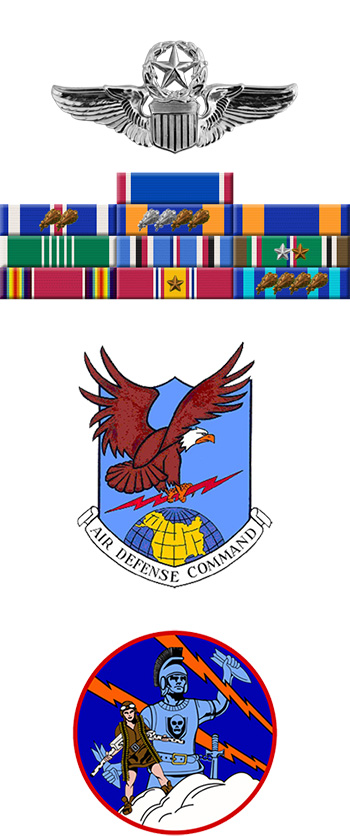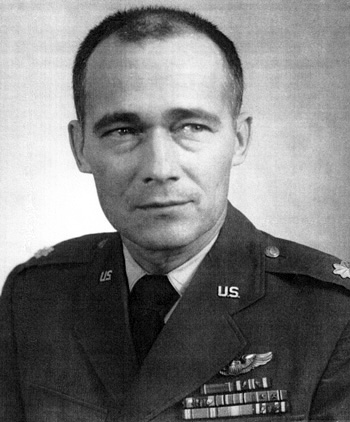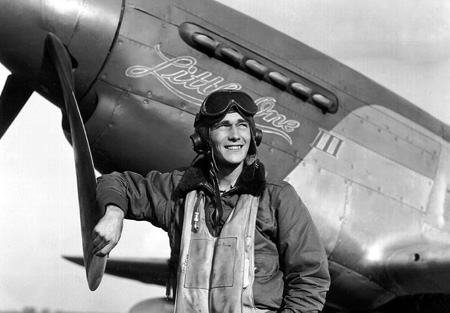
|
Donald S. Bryan |
 |
|||
| Rank, Service | ||||
Lieutenant Colonel O-5, U.S. Air Force |
||||
| Veteran of: | ||||
|
||||
| Tribute: | ||||
Don Bryan was born on August 15, 1921, in Hollister, California. He enlisted in the Aviation Cadet Program of the U.S. Army Air Forces on January 6, 1942, and was commissioned a 2d Lt and awarded his pilot wings at Luke Field, Arizona, on July 26, 1942. After pilot training, Lt Bryan completed P-40 Warhawk transition training from July to October 1942, followed by service as a P-40 pilot with the 304th Fighter Squadron of the 337th Fighter Group at Drew Field and then Sarasota Army Airfield, Florida, from October 1942 to March 1943. His next assignment was as a P-47 Thunderbolt pilot with the 328th Fighter Squadron of the 352nd Fighter Group at Mitchel Field, New York, from March to June 1943, and then in England from July 1943 to May 1945. During this time he was credited with the destruction of 13.333 enemy aircraft in aerial combat, plus 4 damaged in the air, and he served as Commander of the 328th Fighter Squadron from January to April 1945. After returning to the U.S. and taking leave, Capt Bryan served as Assistant Air Inspector of Operations and Training with the 342nd Base Unit in Florida from July to September 1945, followed by service as Director of Operations and Training and then as a Recruiting Officer with the 356th Base Unit at Marshall Army Airfield, Kansas, from September 1945 to November 1946. His next assignment was as an Operations Officer and then as an Instructor with the 308th Base Unit at Tyndall Field, Florida, from November 1946 to November 1947, and then as an Instructor, Supply Officer, and Air Force Exchange Officer with the 500th Air University Wing, the 3831st Air Base Group, and then the 3625th Training Wing at Tyndall AFB from November 1947 to July 1951. Maj Bryan served as a Flying Safety Officer with the Inspector General's Office at Headquarters Air Training Command at Scott AFB, Illinois, from August 1951 to August 1954, followed by Air Command and Staff School at Maxwell AFB, Alabama, from August 1954 to July 1955. Lt Col Bryan next completed Jet Qualification Training at Craig AFB, Alabama, in August 1955, and then Advanced Fighter-Interceptor Training at Tyndall AFB in December 1955 before serving as Director of Plans and Programs and then Director of Operations and Training with the 85th Air Division at Andrews AFB, Washington, D.C., from December 1955 to June 1957. His next assignment was as Chief of the Operations and Plans Division with Headquarters 5th Air Force in Tokyo, Japan, from July to October 1957, and then as Current Operations Officer with the 6102nd Air Base Wing at Yokota AB, Japan, from October 1957 to July 1958. He served as Chief of the Training and Operations Division, Chief of the Combat Operations Division, and then Chief of Plans and Programs with Headquarters 41st Air Division at Johnson AB, Japan, from July 1958 to August 1960, followed by service as Chief of the Plans Division, Chief of the Weapons Evaluation Branch, Assistant Director of Plans and Programs, and then as Chief of the Programs Division with the 26th Air Division at Hancock Field and Stewart AFB, New York, from August 1960 until his retirement from the Air Force on December 1, 1964. Don Bryan Flew West on May 15, 2012, and was buried at the Christ Episcopal Church Urn Garden in Valdosta, Georgia. |
||||
|
||||


